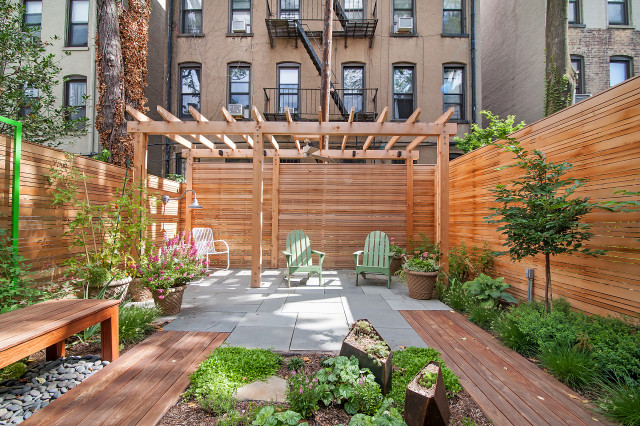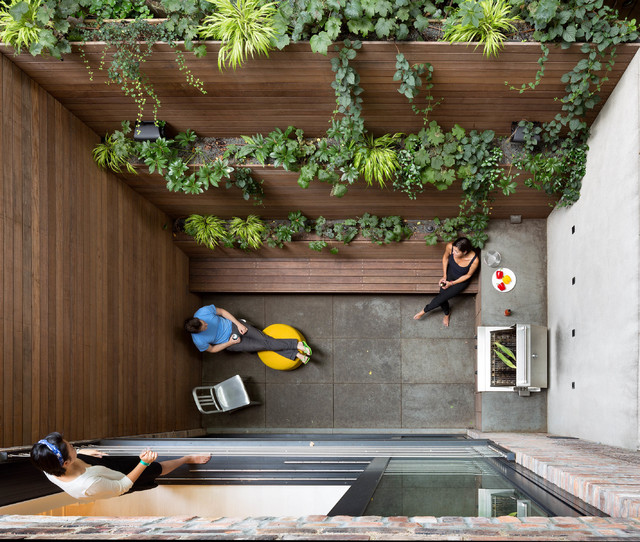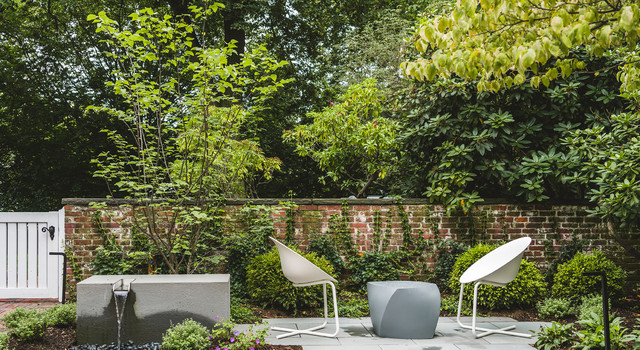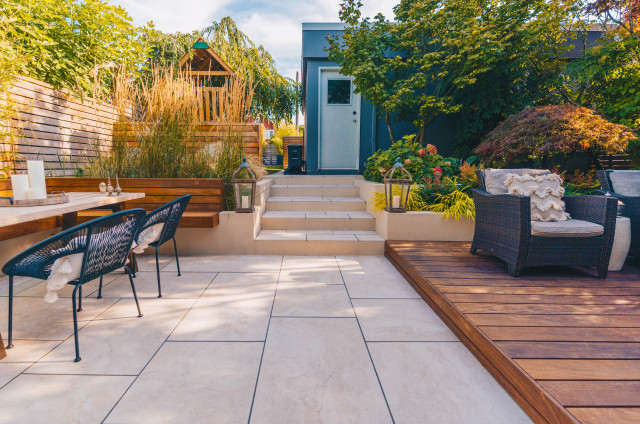How to Renovate a Small Backyard
A small backyard can hold more than a patio, a few plants and some grass. With the right design and some clever moves to visually expand your space, you can add more features than you might imagine.
In many ways, renovating a small yard is no different than tackling a larger space — you’ll still collect inspiration photos, establish a budget and hire a professional, among many other things. However, given more limited square footage and the likelihood of closer neighbors, you’ll have to prioritize what you want, think about multiuse features and consider adding screening or noise-mitigating features.
If you’re ready renovate your outdoor space, read on to learn how to navigate the process through the planning and conceptual phases, and how to get from your current look to one that fits your life and style.
1. Assess Your Existing Outdoor Space
Walk around your yard and note what’s already there. You might even consider making a basic sketch of your space, including any existing features such as patios.
Take a look at what works well in your yard. That might include a patio or deck or any paths. Are there good views you’d like to preserve? Do you have plantings or other landscaping that you like?
Indicate any trouble spots. Do you need to screen an unpleasant view or provide privacy from the neighbors? Do you want protection from overly hot areas, whether with a shade structure or additional trees? Are there issues with drainage or slopes?
Check the weather patterns as well. Are there spots where the sun is blazingly hot for a good portion of the day, or ones that are always cool or cold? Is there a prevailing wind most afternoons, or do things stay relatively calm?
Walk around your yard and note what’s already there. You might even consider making a basic sketch of your space, including any existing features such as patios.
Take a look at what works well in your yard. That might include a patio or deck or any paths. Are there good views you’d like to preserve? Do you have plantings or other landscaping that you like?
Indicate any trouble spots. Do you need to screen an unpleasant view or provide privacy from the neighbors? Do you want protection from overly hot areas, whether with a shade structure or additional trees? Are there issues with drainage or slopes?
Check the weather patterns as well. Are there spots where the sun is blazingly hot for a good portion of the day, or ones that are always cool or cold? Is there a prevailing wind most afternoons, or do things stay relatively calm?
2. Think About What You Want in Your Yard
Make a list of the features you would want in your ideal yard. Envision your dream space, both how it will look and how it will function. Then ask yourself some questions.
Consider possible compromises that could allow you to add a few more dream items to your space. A full-size outdoor kitchen may be out of reach, both in budget and size, but a grill with a countertop or bar area nearby might be doable. You may not have room for a pool where you could swim laps, but a plunge pool or spa may satisfy your wish for a place to relax in the water.
Make a list of the features you would want in your ideal yard. Envision your dream space, both how it will look and how it will function. Then ask yourself some questions.
- Who will be using it regularly?
- Do you want an area for sports and games?
- Would you like a great entertainment spot?
- Is there a feature you’ve always wanted, such as a pool or hot tub, a thriving vegetable garden or a swing designed for relaxing with a good book?
Consider possible compromises that could allow you to add a few more dream items to your space. A full-size outdoor kitchen may be out of reach, both in budget and size, but a grill with a countertop or bar area nearby might be doable. You may not have room for a pool where you could swim laps, but a plunge pool or spa may satisfy your wish for a place to relax in the water.
Finally, take a hard look at your budget and determine how much you can afford to spend on your landscape renovation. You can do some research to get an idea of costs, but the landscape pro you work with will be better able to give you a realistic picture of what you can achieve with your budget. You also can think about where you’d like to invest in your landscape renovation and where you might be able to save.
3. Gather Ideas and Refine Your Landscape Design Style
Now comes the fun part. Pull together photos of outdoor spaces you like. Start by creating a Houzz ideabook to save images of landscapes that you’re drawn to. Mix photos of full landscapes with those showing small details you admire.
At this point, don’t feel like you need to stick to photos of only smaller spaces. Images of larger landscapes can help inspire your project too. Keep in mind, though, that specific features might not be possible to include, or certain results achieved, in limited square footage.
Once you have a good collection of photos, sort through what you’ve gathered and evaluate what you like about each landscape and detail. It will give you and your designer a clearer idea of the direction you want to go in.

Now comes the fun part. Pull together photos of outdoor spaces you like. Start by creating a Houzz ideabook to save images of landscapes that you’re drawn to. Mix photos of full landscapes with those showing small details you admire.
At this point, don’t feel like you need to stick to photos of only smaller spaces. Images of larger landscapes can help inspire your project too. Keep in mind, though, that specific features might not be possible to include, or certain results achieved, in limited square footage.
Once you have a good collection of photos, sort through what you’ve gathered and evaluate what you like about each landscape and detail. It will give you and your designer a clearer idea of the direction you want to go in.

4. Find a Professional
Got your ideas and a preliminary budget? Look for a design pro to help with your project. Both landscape architects and landscape designers can provide a complete design.
There are a number of ways you can work with a designer. A design consultation can get you started, or you can hire a designer to complete a concept design (more on that later) or create a site plan to take you further along. Finally, your designer may also oversee the installation.
Though the skills and expertise of landscape designers and landscape architects can vary widely, the main difference between the two is that landscape architects are licensed and registered with the state. Whether you choose to hire a landscape architect or a landscape designer will likely come down to personal preference and your project’s complexity and requirements.
Got your ideas and a preliminary budget? Look for a design pro to help with your project. Both landscape architects and landscape designers can provide a complete design.
There are a number of ways you can work with a designer. A design consultation can get you started, or you can hire a designer to complete a concept design (more on that later) or create a site plan to take you further along. Finally, your designer may also oversee the installation.
Though the skills and expertise of landscape designers and landscape architects can vary widely, the main difference between the two is that landscape architects are licensed and registered with the state. Whether you choose to hire a landscape architect or a landscape designer will likely come down to personal preference and your project’s complexity and requirements.
Your project may require a landscape architect if there are grading and drainage issues, retaining or structural walls, or features such as a large driveway and turnaround. Other issues that may require a landscape architect include mitigations for wetlands or protected sites, or the possibility of floods, wildfires, mudslides or hurricanes.
You also can work with a landscape design-build firm, which can carry your project from the design phase through installation. A full-service landscape design firm also may be able to provide continued maintenance once the project wraps up.
You also can work with a landscape design-build firm, which can carry your project from the design phase through installation. A full-service landscape design firm also may be able to provide continued maintenance once the project wraps up.
5. Explore Small Yard Design Ideas
A number of design moves can make a small yard feel more expansive. Consider whether any of the following options could suit your overall look and style. Your designer will be able to provide you with the solutions best suited to your space and needs.

A number of design moves can make a small yard feel more expansive. Consider whether any of the following options could suit your overall look and style. Your designer will be able to provide you with the solutions best suited to your space and needs.
- Choose a simple palette of a few colors for hardscape, furnishings and plantings that repeat throughout the space. This will draw your eye through the yard and make the space feel unified and larger.
- Lay a path at an angle to make a narrow yard feel wider.
- Install a circular path to draw the eye around the yard, rather than through it. Having the end of a path disappear behind a landscape feature gives the sense that there are more areas of the yard to explore.
- Create a destination with a patio or a deck sited halfway through or at the far end of a small yard, rather than right outside your door. It will draw people through the space.
- Highlight a view that’s beyond the borders of your space to expand the sense of spaciousness.
- Designing two distinct zones, such as a dining space and a gathering spot or a play area, gives a sense of purpose to even the smallest space. If you’re dealing with a slope, consider a small retaining wall as a design feature that also adds separation.

6. Decide on the Concept Design
Taking your landscape from ideas to reality starts with developing the concept design. Your designer will use your ideas and his or her own preliminary sketches to create a preliminary site plan. This two- or three-dimensional drawing will be to scale and will show the new layout and major design elements. At this point, it may be fairly simple or can be quite detailed, indicating materials and plantings. Your designer might provide additional drawings to support the site plan and convey the overall design.
Review all aspects of the plan with your designer, from large installations to small details, to be sure you understand how the final design will look in real life.
Some questions you’ll want to ask yourself and your design pro:
Taking your landscape from ideas to reality starts with developing the concept design. Your designer will use your ideas and his or her own preliminary sketches to create a preliminary site plan. This two- or three-dimensional drawing will be to scale and will show the new layout and major design elements. At this point, it may be fairly simple or can be quite detailed, indicating materials and plantings. Your designer might provide additional drawings to support the site plan and convey the overall design.
Review all aspects of the plan with your designer, from large installations to small details, to be sure you understand how the final design will look in real life.
Some questions you’ll want to ask yourself and your design pro:
- How do the various components work together, and how you will access areas throughout the space?
- Are the walkways and drives large enough so they don’t feel cramped? Is there sufficient room for features, from grills to swimming pools, and for furnishings such as dining tables and lounges?
- Does the look fit your style and work with your architecture? Is the plant palette what you want for your garden?
- Can you imagine yourself in the space?
7. Choose Materials and Accessories
Throughout this process, you’ll have been saving inspiration photos to your Houzz ideabooks, and you’ll likely already have an idea how you want your space to look.
Now you’ll need to work with your designer or supplier to select the materials and accessories for your landscape. These include everything from hardscape and plants to extra features and finishing details.
As you finalize your plans, check out your options and see how they fit with your style, your design and your budget. Things to consider:
Throughout this process, you’ll have been saving inspiration photos to your Houzz ideabooks, and you’ll likely already have an idea how you want your space to look.
Now you’ll need to work with your designer or supplier to select the materials and accessories for your landscape. These include everything from hardscape and plants to extra features and finishing details.
As you finalize your plans, check out your options and see how they fit with your style, your design and your budget. Things to consider:
- Hardscape options for decks, patios, paths and retaining walls
- Structural materials for screens, pergolas, arbors, fences and gates
- Fireplace and fire pit
- Outdoor kitchen and grill
- Lighting
- Spa and small pool
- Water feature
- Storage areas
- Plant choices such as ground covers, trees, shrubs, grasses and flowers
- Outdoor furnishings such as tables, chairs, sofas, benches and swings
8. Finalize the Details
Once you’ve decided on a concept plan, it’s time to get all the pieces in place. Your plan will go through several revisions as it is polished. When you and your designer have made all the changes, you will have a final plan to follow.
One of the details that will need to be considered during this process is which permits and permissions you will need, including those from a homeowners association, if applicable. If you’re planning a major renovation, be sure that you or your pro contact the correct authorities to determine the location of gas, power and plumbing lines. These all should be carefully marked.
A knowledgeable professional will be able to guide this portion of the process, as he or she will be familiar with local planning departments, permit requirements and any other logistical issues you’ll need to address.
Once you’ve decided on a concept plan, it’s time to get all the pieces in place. Your plan will go through several revisions as it is polished. When you and your designer have made all the changes, you will have a final plan to follow.
One of the details that will need to be considered during this process is which permits and permissions you will need, including those from a homeowners association, if applicable. If you’re planning a major renovation, be sure that you or your pro contact the correct authorities to determine the location of gas, power and plumbing lines. These all should be carefully marked.
A knowledgeable professional will be able to guide this portion of the process, as he or she will be familiar with local planning departments, permit requirements and any other logistical issues you’ll need to address.
8. Hire a Landscape Contractor
If your landscape architect or designer is part of a design-build firm, which combines design and installation services, the same firm will be able to carry your project through to the finish.
If you don’t already have a licensed landscape contractor for your project, you’ll need to find one to do the installation. You’ll want to interview potential contractors and give them the scope of work, even if the plans aren’t final. Designers often can recommend contractors they’ve successfully worked with in the past. Interview at least three to get a good idea of your options.
When looking for a contractor, follow the same process as for choosing a landscape architect or designer. Also ask about insurance and bonds for any subcontractors, as well as about a contact person for questions and problems that may arise.
If your landscape architect or designer is part of a design-build firm, which combines design and installation services, the same firm will be able to carry your project through to the finish.
If you don’t already have a licensed landscape contractor for your project, you’ll need to find one to do the installation. You’ll want to interview potential contractors and give them the scope of work, even if the plans aren’t final. Designers often can recommend contractors they’ve successfully worked with in the past. Interview at least three to get a good idea of your options.
When looking for a contractor, follow the same process as for choosing a landscape architect or designer. Also ask about insurance and bonds for any subcontractors, as well as about a contact person for questions and problems that may arise.
9. Plan for Construction and Understand the Timeline
Before work begins, familiarize yourself with how the project should unfold and how long it will take from start to finish. Ask about the disruption to your yard and access to your home, as well as about construction hours; staging areas for materials; outside contractors for electrical, plumbing and irrigation systems; and who will be your contact person for questions or problems.
You’ll also want to be aware of possible setbacks that may cause the timeline to change. These may range from weather delays to subcontractor availability to supply chain issues. Ask about backup plans if problems arise.
If you are saving part of your landscape, especially trees or bushes, ensure that those areas are marked and protected from damage, especially during demolition. Also consider incorporating sustainable approaches to your landscape construction.
Before work begins, familiarize yourself with how the project should unfold and how long it will take from start to finish. Ask about the disruption to your yard and access to your home, as well as about construction hours; staging areas for materials; outside contractors for electrical, plumbing and irrigation systems; and who will be your contact person for questions or problems.
You’ll also want to be aware of possible setbacks that may cause the timeline to change. These may range from weather delays to subcontractor availability to supply chain issues. Ask about backup plans if problems arise.
If you are saving part of your landscape, especially trees or bushes, ensure that those areas are marked and protected from damage, especially during demolition. Also consider incorporating sustainable approaches to your landscape construction.
10. Make a Post-Completion Punch List
After the paving has been laid, the lighting has been installed, the plantings have been put in place and the finishing touches have been added, walk through your yard and note anything that is still unfinished. Provide the person responsible for correcting any mistakes with a list of items that need to be fixed and ask for a final finish date.
Also, you’ll want to think about and plan for maintenance. The hardscape materials and plantings will need ongoing care. Some landscape design and landscape construction companies provide maintenance services, which may be part of your service agreement with the pro. You also can ask your designer or contractor for maintenance recommendations or contacts.
After the paving has been laid, the lighting has been installed, the plantings have been put in place and the finishing touches have been added, walk through your yard and note anything that is still unfinished. Provide the person responsible for correcting any mistakes with a list of items that need to be fixed and ask for a final finish date.
Also, you’ll want to think about and plan for maintenance. The hardscape materials and plantings will need ongoing care. Some landscape design and landscape construction companies provide maintenance services, which may be part of your service agreement with the pro. You also can ask your designer or contractor for maintenance recommendations or contacts.











Comments
Post a Comment